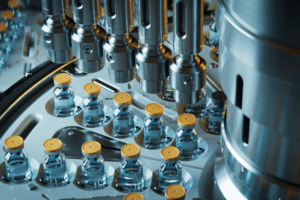August 10, 2023
Behind laboratory doors nationwide, groundbreaking genetic analyses and unprecedented technological advancements are changing healthcare as we know it. Genomic sequencing can enable scientists to stratify cancer, characterize genetic diseases and develop effective treatments, among other feats. The rise of genomic sequencing will have serious implication for insurers and the laboratories where these advancements take place. Laboratories are prone to disaster events and have similar risks to other properties. But there’s one key difference: many labs house hazardous chemical compounds and even more are equipped with expensive scientific equipment.
Think of a genome as a comprehensive manual that contains instructions for our bodies to develop and operate, from the time of conception to the person you are today. Each cell in the body contains a complete set of instructions for how to build and maintain the body throughout life. The genome promotes growth, guides organs to do their jobs and helps the body repair itself when injured/ill. These instructions are written on genetic material, commonly known as DNA.
The more doctors learn about individual genomes, the more humans will collectively benefit. But within the walls of the laboratories that research the science lies unique property risks, be it the building structure or the equipment. To understand exposures and restore facilities to their pre-loss state quickly requires guidance from experts fully versed in laboratory loss mitigation.
The science behind it all
Genomic sequencing — followed by gene editing — could make daily dosing of some medications a thing of the past. For instance, rather than managing low-density lipoprotein (LCL-C) levels — the bad cholesterol — with drugs, it could be lowered for good with a single injection. The first human genome was read/decoded in 2001, astonishing the science world and helping the research community decipher how we are built, how flaws/mutations in DNA cause certain ailments and how we may respond to different medicines. Genomic sequencing is the action of decoding DNA — or more specifically, determining the order of the four chemical building blocks called “bases” that make up the DNA molecule.
The types of laboratories
Today, a range of laboratories exist, each serving their own purpose. Most familiarly, clinical or medical laboratories process comprehensive blood tests ordered at annual physicals. University laboratories focus on scientific research or research in the humanities. Analytical and quality laboratories, by contrast, house products and materials testing that ensures products conform to manufacturer specifications. Such labs play an essential role in the production and supply chain.
Within research and development (R&D) laboratories specifically, there are a broad spectrum of facilities that carry various risks. Biosafety labs house potentially harmful biological agents; other laboratories may face radioactive risks. We must also consider the national laboratories that conduct energy technology research funded by the U.S. Department of Energy, including projects such as the Human Genome Project — an endeavor that led to our ability to now sequence any person’s genome.
Property loss scenarios
Laboratories can contain highly flammable chemicals, compressed flammable gases, as well as hydrocarbons and high-temperature equipment, so it’s no surprise that they are far from immune to disaster events. One incident occurred when a researcher combined several high-pressure gases into a lower pressure steel gas tank. A spark from the pressure gauge caused a large explosion that resulted in the researcher losing an arm.
Another particularly severe incident occurred at a laboratory that specialized in design and manufacturing of specialty chemicals for gasoline additives and printing industry solvents. An explosion occurred within a 2500-gallon batch reactor during production of a chemical compound — MCMT, which is an organomanganese compound used as an octane-increasing gasoline additive — after the reactor’s cooling system failed. The cooling system lacked a backup. Pressure and temperature increased in the reactor until it violently ruptured and the MCMT exploded, destroying the reactor. This resulted in four deaths, injury to 14 others and four buildings in the plant’s vicinity being condemned.
Laboratories are one of the few environments where four of the five classes of fire can occur individually or in combination. Equipment overheating, for example, can result in sustained fire damage. In one instance, a flash fire sparked at a university lab from loss of cooling water when a plumber shut off water to fix a leak. Without cooling water, the solvent, used in an experiment, ignited and burst into flames.
Recovery and prevention
Of all scenarios, spills are most prevalent (45%), followed by explosions (23%) then fires (21%) — all of which can harm personnel and shut down/delay production. Adverse weather, improper equipment installation, facility maintenance and equipment failures impact laboratories as well. Unfortunately, in many cases, lab personnel inadvertently cause the loss — making hazard training, personal protective equipment (PPE) and risk assessments so critical.
EFI Global’s engineers and investigators are well versed in laboratory loss mitigation and can provide recommendations following a loss to help return the facility and the equipment to its pre-loss condition, in an effort to prevent extended downtime.
Learn more > visit efiglobal.com or check out an expanded version of this article here.



